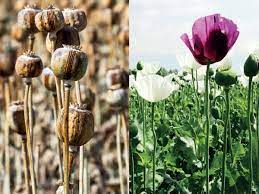Description

Disclaimer: Copyright infringement not intended.
Context
- India has opened up the highly regulated sector of producing and processing opium to private players.
Since when has opium been grown in India?
- India has been growing poppy at least since the 15th century, as per historical records. The British East India Company assumed monopoly on the cultivation of poppy when the Mughal Empire was on the decline, and the entire trade was brought under government control by 1873.
- After India gained independence, the cultivation and trade of opium passed on to the Indian government, with the activity being controlled by The Opium Act, 1857, The Opium Act, 1878, and The Dangerous Drugs Act, 1930. At present, the cultivation and processing of poppy and opium is controlled by the provisions of The Narcotic Drugs and Psychotropic Substances (NDPS) Act and Rules.
What is the process of growing and processing opium in India?
- Due to the potential for illicit trade and risk of addiction, the cultivation of opium poppy is strictly regulated in the country, with the crops being allowed to be sown only in tracts of land notified by the central government in 22 districts in the states of Madhya Pradesh, Uttar Pradesh, and Rajasthan.
- The government announces the licensing policy for opium cultivation every year, providing details on minimum qualifying yield, the maximum area that can be cultivated by a single cultivator, and the maximum benefit that is allowed to cultivators for damage to the crop due to natural causes.
- The cultivation of opium poppy is strictly monitored — the government uses satellite images to check for illicit cultivation. Once the crop is ready, they have a formula on how much the yield should be. This entire quantity is then bought by the government and processed in its own factories.
- The opium produced in the country is currently processed entirely at the Government Opium and Alkaloid Factories in Uttar Pradesh’s Ghazipur and Madhya Pradesh’s Neemuch. Products such as morphine, codeine, thebaine, and oxycodone are produced.
What is opium used for?
- Opium is a natural substance obtained from poppy seeds and its derivatives are mainly used for pain management.
- The extracts from opium poppy such as morphine are potent painkillers and are mainly prescribed to cancer patients. The opium product codeine is helpful in cough suppression.
- It is used illicitly for smoking, drinking, or even eating as pills. The addictive properties of opium are the reason that the cultivation of poppy is highly regulated around the world. Only 12 countries including India allow its cultivation legally for medicinal use.
How does the involvement of private players help?
- The involvement of the private sector might boost the domestic production of various alkaloids such as morphine and codeine, bring in modern technology, and reduce imports. Despite being one of the few global cultivators of poppy, India still imports these active pharmaceutical ingredients as well as poppy seeds, which is also consumed as a food item in the country.
https://indianexpress.com/article/explained/india-opium-production-regulation-bajaj-healthcare-8040545/
1.png)













